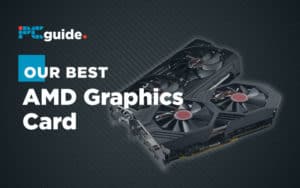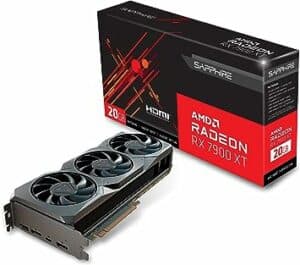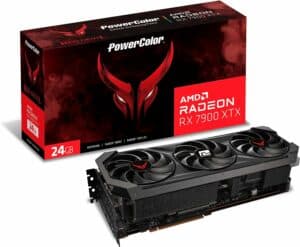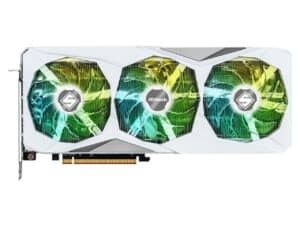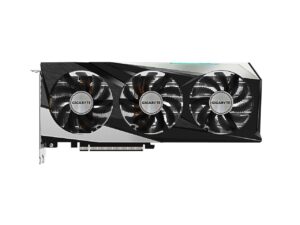Best AMD graphics cards in 2024 – The top GPUs for Team Red
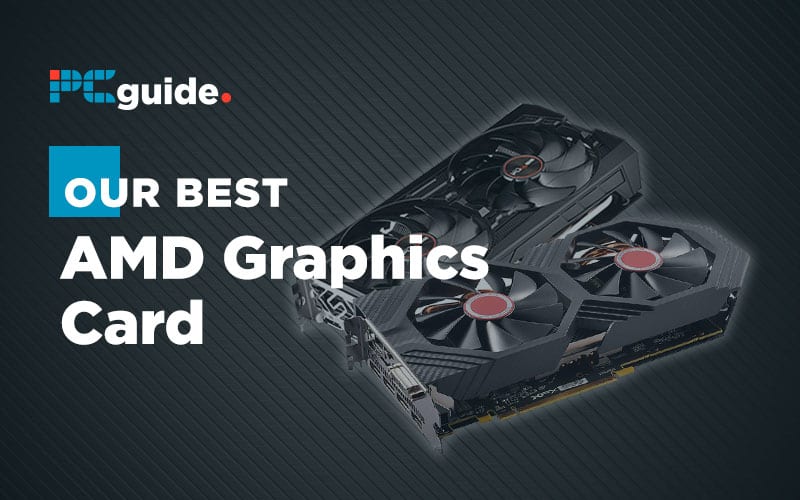
Alongside Nvidia, AMD remains at the forefront of the graphics card market, offering top-notch technology and advanced designs that deliver exceptional performance and efficiency. AMD’s graphics cards are highly regarded for their ability to push the limits of visual computer/PC gaming, making them the go-to choice for gamers and professionals alike. From the enthusiast-grade Radeon RX series to the high-performance Radeon Pro lineup, AMD’s best graphics cards deliver stunning visuals, smooth gameplay, and powerful productivity tools. This guide explores the best AMD graphics cards of 2024, highlighting their standout features, performance, and the benefits they bring to users across various fields. So. lets check them out, shall we?
Products at a Glance
How we selected the best AMD graphics cards
To choose the best AMD graphics cards, we underwent a thorough process of investigation to find the top GPUs currently on the market. Our process involved delving into the intricate details of each card, considering factors such as its processing speed, special features, affordability, and user satisfaction. We meticulously scrutinized the technical specifications, including the architecture of the graphics processing unit (GPU), the amount of memory available, and the efficiency of the cooling system.
Through rigorous benchmarking and real-world testing, we have gained valuable insights into the cards’ performance across a variety of tasks, from gaming to professional/creative applications like rendering and video editing. Furthermore, we took into account the feedback and opinions of both our own in-house experts, third-party reviewers and everyday users, ensuring a well-rounded understanding of each card’s strengths and weaknesses.
Interested in finding more buying guides? We also have the overall best graphics cards on the market (including Nvidia and Intel), as well as the best budget graphics cards. Be sure to check them out.
Product Reviews
- Dominates last-gen cards
- Efficient cooling system
- Innovative chiplet design
- Priced closely to RX 7900 XTX
- Power consumption might concern some
- Larger TDP than some competitors
At its core, the AMD Radeon RX 7900 XT is powered by the Navi 31 graphics processor and boasts a solid GPU base clock of 2000 MHz, ramping up to a boost clock of 2400 MHz. With a generous 20GB of GDDR6X graphics memory and a board power of 315 watts, this GPU sits pretty much at the top tier of graphics cards.
Diving a bit deeper into its performance metrics, the RX 7900 XT holds its own quite well, even when compared to its pricier sibling, the RX 7900 XTX. With just a 10% difference in pricing (RX 7900 XT priced at $899 and RX 7900 XTX at $999), users get a card that confidently outperforms all the predecessors.
The move to a chipset-based design, inclusive of the GCD and MCDs, hints at AMD’s innovative approach to achieving efficiency and performance. This design ensures the primary functions are handled by the GCD, while the MCDs take care of the memory controllers and Infinity Cache.
- Stellar gaming performance
- Competitive price for a premium card
- Compatible with most cases
- Creative performance is middling
- Ray tracing lags behind Nvidia's latest
- Drinks up power
Armed with 4,864 stream processors and a memory powerhouse of 24GB GDDR6, the AMD Radeon RX 7900 XTX showcases its prowess right from the spec sheet. With a core clock speed of 1,900MHz and an impressive boost of 2,500MHz, it brings forth a robust gaming experience.
Making its debut at the tail end of 2022, the RX 7900 XTX, priced under $1,000, wasn’t just aiming to impress; it sought to dominate. And dominate it did! Successfully outmatching the pricier Nvidia RTX 4080 in multiple parameters, this GPU demonstrated it was money well spent.
A notable feature here is the introduction of 2nd-gen ray accelerators. With these, AMD has brought 4K gaming with ultra settings and ray tracing to its forefront, addressing one of the lingering issues with its predecessor, the RX 6950 XT.
- Excellent for 1440p and 1080p gaming
- Generous 16GB VRAM
- Notable rasterization capabilities
- Only a slight edge over the RX 6800 XT
- Could be quieter
The AMD Radeon RX 7800 XT, anchored by the AMD Navi 32 Graphics Processor, is certainly a performer to reckon with. Boasting a base clock speed of 2124 MHz that can boost up to 2430 MHz, it’s designed to satisfy gamers and creators alike. Coupled with 16GB of GDDR6 memory, it assures users that VRAM will not be a limiting factor in their endeavors.
Stepping into the spotlight, the RX 7800 XT shines brightly when it comes to 1080p and 1440p gaming. That beefy 16GB of VRAM will undoubtedly keep future game titles running smoothly, and the card’s rasterization performance is commendable.
It’s also impressive to see AMD focusing on future-proofing, with the inclusion of DP2.1, AV1, and other architectural enhancements that make it a robust choice for the years to come.
- Superb value for money
- Stellar 1080p gaming capabilities
- Holds its own in 1440p
- Limited to 8GB VRAM
- Ray tracing could be better
- FSR performance behind Nvidia
Meet the AMD Radeon RX 7600: an entry into the AMD RDNA 3 lineup that doesn’t hurt your wallet but certainly doesn’t skimp on performance. With its 2048 Stream Processors, 8 GB of GDDR6 memory, and a boost clock that hits a surprising 2,625MHz, this card is a statement by AMD in the affordable GPU segment.
Its 165W TDP ensures it remains relatively power-efficient, while that boost clock and memory speed promise snappy performance. The power draw is impressively close to its rated TDP, with tested maximum consumption only hitting 164W.
The RX 7600 really sells itself with its 1080p capabilities. For gamers on a budget who don’t want to compromise on performance, this GPU is a boon. If you’re gaming at 1080p, expect seamless gameplay with most titles maxed out
Choosing the best AMD graphics card for your system
While we’ve covered the performance of each individual AMD GPU highlighted above, there are a few other compatibility concerns and FAQs we’d like to cover here.
First and foremost, let’s talk about physical compatibility.
Width
Width is measured in the number of PCI slots taken up by the graphics card on both your motherboard and chassis. The average width for most graphics cards is 2 slots, but some particularly beefy cards can come in at 3 slots. A few fall somewhere between that, though those are still (in effect) 3-slot cards since they still obscure the next slot down.
Unless you’re in a very space-constrained Mini ITX or HTPC chassis, GPU width is unlikely to cause an issue. Few consumers use more than one expansion card in today’s PC market, but for those who do, keeping graphics card width in mind is important information before buying.
Length
Length is the much more prominent measurement when it comes to concerns of GPU compatibility, and that’s because a long GPU is less likely to fit in your system than a thick one. The standard for GPU length is measured in millimeters (mm), and measures the longest side of the graphics card.
We’ve included this specification for each of our GPU picks so that you can double-check whether or not the card will fit in your system before buying. For many high-performance cards with beefy coolers, this is especially important to verify. If you aren’t sure what the maximum GPU length your case can support is, look it up on your manufacturer’s site or measure it yourself.
While you can return an incompatible GPU when it arrives, we imagine you’d rather buy one that fits in the first place. So double-check before buying!
Power Requirements
The power requirements provided by manufacturers are more like recommendations, especially for modern, low-power systems. If you want to keep it safe and don’t feel like doing wattage calculation, then stick with the recommendations.
If you want to save some money while also ensuring that your PC will be safely operating with your power supply, use a PSU wattage calculator in order to tally the power draw of your components. So long as they don’t exceed PSU capacity, you’re good- but more room to breathe for your PSU is always better.
What difference does VRAM amount and type make?
So there are a lot of different VRAM types and capacities being thrown around in this article.
VRAM has a high impact on maximum texture detail and resolution that your graphics card can output. This is determined by both the speed of the VRAM and the quantity of the VRAM. GDDR5 VRAM, used by the RX 580, isn’t as fast as GDDR6. However, the sheer quantity- 8GB- makes it appropriate for 1440p and even 4K with older games, so long as settings are kept in check.
GDDR6 VRAM can achieve the same or better results with less total VRAM. If you have 6GB+ of GDDR6 VRAM, you’re unlikely to ever be VRAM-constrained…but you’ll still be held back by the raw power of the rest of your GPU, which may not be able to keep up with games at super high settings or resolutions.
If you end up being tempted by something like a last-gen RX 570, a different RX 580, or even an RX 590…make sure that you get the 8GB models! The 4GB models perform pretty much the same in 1080p, but your 1440p and higher resolution gaming will suffer as a result of VRAM constraints.
A brief note on video ports
You’ll notice a few different video ports supported by each of these graphics cards. Here’s what sets them apart:
- DVI – Oldest standard supported by modern GPUs, limited to 1080p at 144 Hz or 1440p at 60 Hz. Cannot do higher resolutions, and does not pass through sound.
- HDMI – Most common HD video standard for TVs and other consumer electronics. Supports 4K @ 60 Hz, but support of lower resolutions at higher frame rates will vary, especially for resolutions like 1440p. We recommend only using HDMI with 1080p and 4K resolutions, and only when used with a TV. This standard does offer audio pass-through.
- DisplayPort – Offers the highest bandwidth and most flexible support for PC resolutions and refresh rates. The PC display standard. Recommended for use with your PC monitor, especially for high-refresh gaming. This standard also offers audio pass-through, but is not compatible with most TVs.
Note: Some games, especially eSports titles, are much lighter than other modern games and can generally be pushed farther than these targets.
- 1080p & 200+ FPS at high-to-max settings in modern games
- 1440p & 100+ FPS at high-to-max settings in modern games
- 1800p & 60+ FPS at high-to-max settings in modern games
- Native 4K & ~60 FPS at high settings in modern games (adjustments recommended)
Should I go AMD or Nvidia?
AMD offers better prices and with the recent launch of FSR 3.0, the Red Team inches ever closer to Nvidia’s DLSS in terms of quality and performance enhancements. Furthermore, when it comes to rasterization performance, AMD currently stands unrivaled. This makes AMD a compelling choice for many.
Our Verdict
